We just spent fifteen weeks talking about Superman games, let’s look at a few Superman comics for a change.
Due to wrapping up college and thus having an unexpected wealth of both income and time, I have never been more “into comics” than from about 2005(ish)-2009. Aside from the previously mentioned “real world” reasons, a significant cause of this addiction was DC’s 2005 Infinite Crisis.
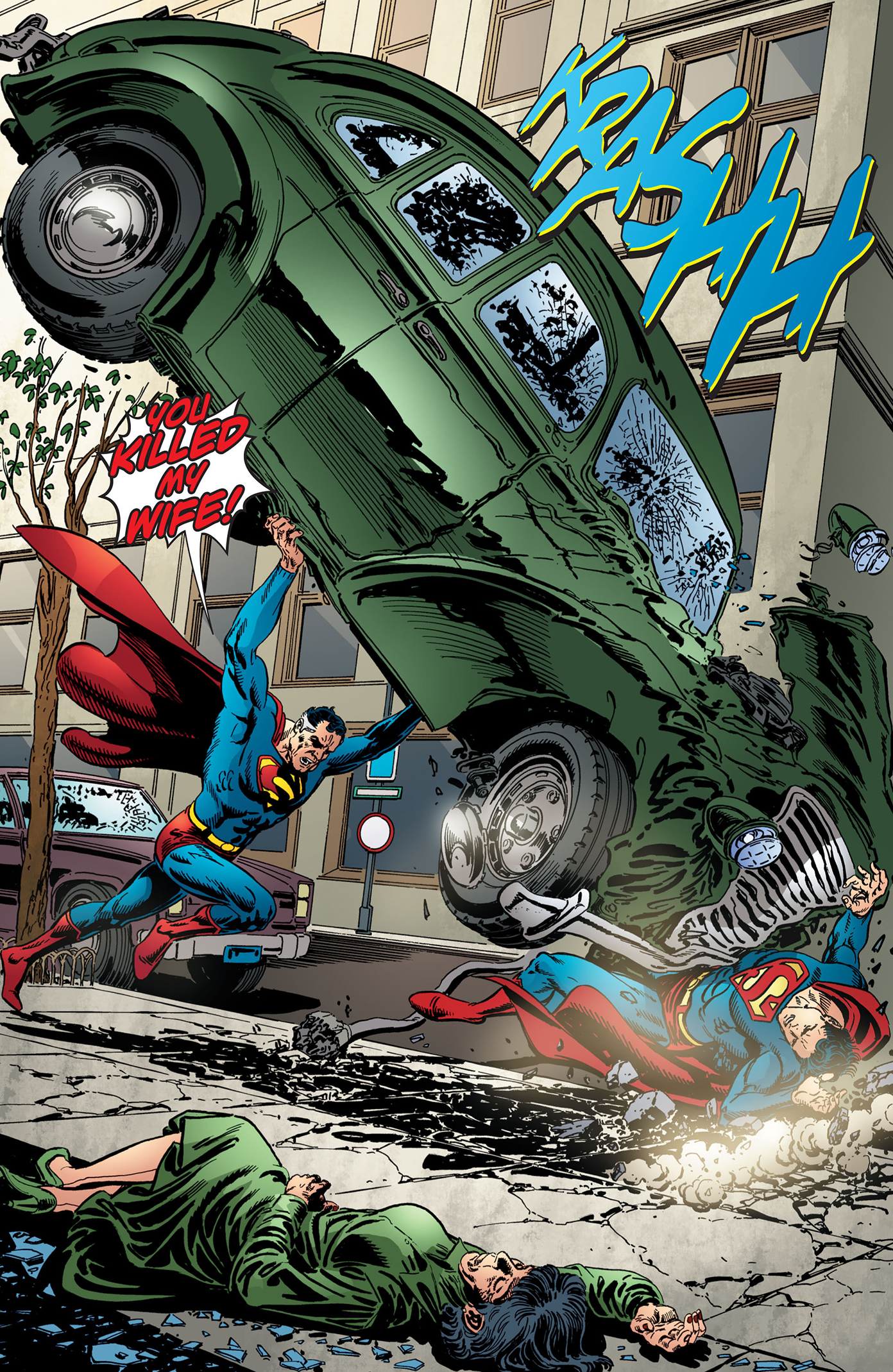
This was the latest event comic series from DC Comics, and it was essentially a direct sequel to 1985’s Crisis on Infinite Earths. While it is a decent story in its own right, it trapped me like a Martian Manhunter tied to a dimensional tower, because it was the “right” kind of crossover for someone that had always been familiar with DC, but didn’t necessarily keep up with the floppies. Superman, Wonder Woman, and Batman were center stage, and the bad guys were (alternate) Lex Luthor and a “bad” version of Superman or two. I know those characters! And while there had been an entire library’s worth of “lead up” comics for this event (OMAC Project, Rann-Thanagar War, Day of Vengeance, Villains United) they were all straightforward in their contributions. For instance, Rann-Thanagar War was a complicated tale that used some Guardians of the Galaxy-tier heroes to tell what would be a complete Star Wars tale of intergalactic intrigue… but it boiled down to “here is what the space heroes are doing” for Infinite Crisis. I came in late, but the 2-year leadup to Infinite Crisis did ultimately head to a seven-issue comic that even a vague neophyte like myself could fully enjoy and comprehend. Not bad for a comic that Wikipedia lists with the note of “Main Character(s): rest of DC Universe”.
But what came next really hooked me.
Like its literary forefather, Infinite Crisis was another “soft reboot” of the DC Universe. Continuity got reshuffled a tad, and things like “Lex Luthor knew Superman as a teenager” (thanks, then-popular Smallville!) or “Batman has a clear succession of sidekicks” snuck in there after being wiped after the last reboot. But “current” continuity was still the same. Wonder Woman was going to be Wonder Woman next week, so stuff like Infinite Crisis and Diana snapping necks and taking names still happened. Thus, if you cared about these characters, you cared about what happened next, and we got two options for that.
One Year Later wasn’t a “focused” crossover like Infinite Crisis, but a line-wide editorial mandate. Every single DC Comic after Infinite Crisis would pick up its continuity “one year later”, and it was all but guaranteed that every comic would have some mystery that occurred during the time off. Catwoman had a baby! Aquaman is a different guy! Half of Firestorm is missing! The Justice Society now has all kinds of weirdos on the team! How did this all happen!? Like most line-wide stories, it worked well in some places (Harvey Dent was holding down the fort while Batman was away? That’s double fun!), and bizarrely compromised other stories (due to Blue Beetle technically gaining his powers during Infinite Crisis, but not receiving any backstory at that time, he basically had to spend a year in a time hole so his “start” was synchronous with the rest of the universe), but it was overall an excellent device. And, like most en media res stories, by the time the questions about what happened are answered, you’re already hooked on the story happening in the present. Good job holding my attention, DC!
But if you did want to know what happened during the “missing year” of DC continuity, there was a solution for that. DC 52 (which was technically only named “52”, but I am going to keep calling it DC 52 to distinguish from simply using the number) was a 52-issue comic that was sold as the true story of the immediate aftermath of Infinite Crisis.
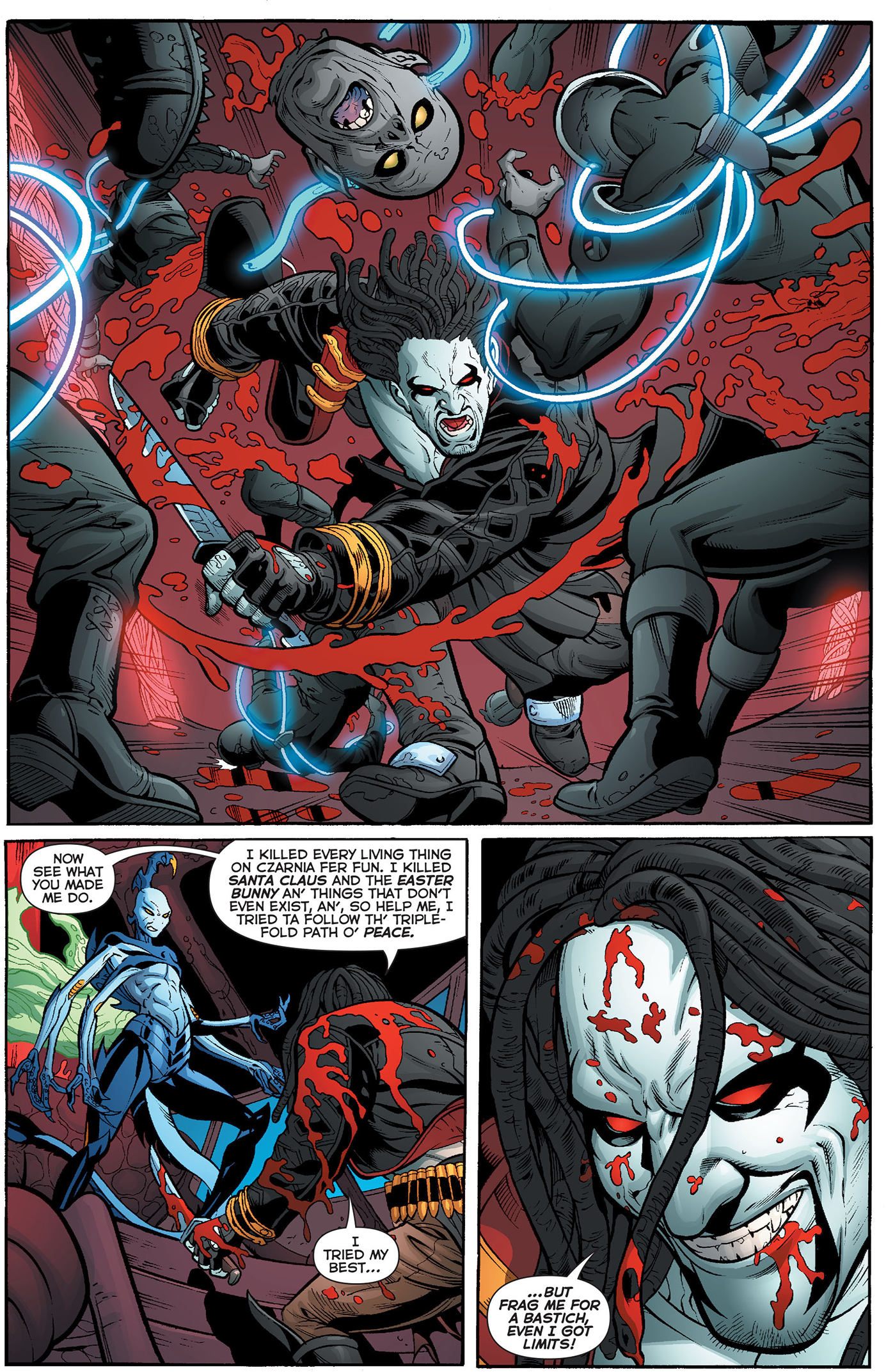
Superman was depowered! Batman was off (re)training! Wonder Woman remembered that she had an apartment at a place literally named Paradise Island! So the big three were out of the picture for the year, and (relatively) lesser-known heroes like Black Adam, Steel, and Starfire were going to have to pick up the slack. We know it all ultimately works out fine (One Year Later DC wasn’t a festering hellhole… except in Blüdhaven), but the devil in the details was good to see (like Ralph Dibny seeing the devil, and shooting him). We got a few premiering characters out of the deal (Batwoman, Question, Everyman, Hungry ol’ Sobek), and unique stories for everyone involved. And here’s a fun fact: as you may have guessed from the title/number of issues, DC 52 ran for a continuous 52 weeks, with a new issue each and every Wednesday. We got manga hours up in this publishing! Somebody check on Grant Morrison!
While all the stories intersect and crossover often, it is basically a handful of different comic books smooshed together. 52 could separately be (spit balling names) Black Adam Family Adventures, Gotham City Lesbians, Better Living Through Super Science, Worse Living Through Super Science, Lobo’s Fun Times in Space (with groupies), The Death and Return of Booster Gold, and Elongated Man’s Guide to Grief (and shooting the devil). And that lineup is just perfect for my complete lack of an attention span! And speaking of ADD, DC 52 was published on a timetable that matched the real world. If it was Halloween week, then it was Halloween in this week’s chunk of the missing year. And even if it is barely a cameo of a concept, simple events like seeing the Justice Society (sadly) celebrate Thanksgiving while you’ve got the holiday coming up tomorrow is instantly endearing. In short, DC 52 was an intersection of several great ideas and concepts, and even if you thought some random bits of pop Zen philosophy dragged, odds were good that next week there would be a glorious battle between crocodile men and raging gods.
DC 52 wound up being one of my favorite complete stories of all time (all media category, not just comics), and I wasn’t alone in my love. Or, if I was alone, DC decided to start marketing exclusively to me. DC 52 wound up with a number of series that spun off directly from its base stories. Booster Gold was the most successful, with a 47 issue (not weekly) run that took the DC 52 interpretation and goals of “that” Booster Gold and ran with it. Black Adam, “The Crime Bible”, Mercury: The Only Metal That is Liquid at Room Temperature, and The Great Ten (who were bit players on the fringes of DC 52, but definitely left an impression) all got limited runs of “aftermath” stories. And Infinity Inc., the super team that was created by Lex Luthor during DC 52, got a solid 12 issues of an ongoing, which is better than what Uncle Sam and the Freedom Fighters could ever hope for. And DC 52 was the premiere of “modern” Batwoman, who is still going strong today, and got a TV show of dubious quality somewhere in there. With all these spinoffs, it would be only natural to see DC 52 earn a dedicated, focused sequel. Why, complete with DC 52 being an ensemble piece, you could do practically anything with the concept of a 52-week comic book, and it would be great!
Countdown started strong. DC 52 was 52 issues of comics that began at the exact end of a major crossover, and Countdown would commence at Issue #51, and count down to zero and the next major crossover. That’s cool! That is, as the kids say, hype. This was also intended to be another “ensemble of weirdos” like DC 52, so the first few issues established that we would be seeing the adventures of some characters that had floundered or were underrepresented in the One Year Later universe. Our luminaries included the likes of Jimmy Olsen, Donna Troy, Mary Marvel, Jason Todd, Harley Quinn, Triplicate Girl, and Pied Piper. Yes, it is rare that someone gets excited about Pied Piper, but nobody cared about Steel’s niece before DC 52, so there was an expectation there. Paul Dini was the first listed writer! That guy knows what he is doing! And DC had learned lessons from DC 52! What worked? What didn’t? We knew “one year later”, so surely the sequel would be even better!
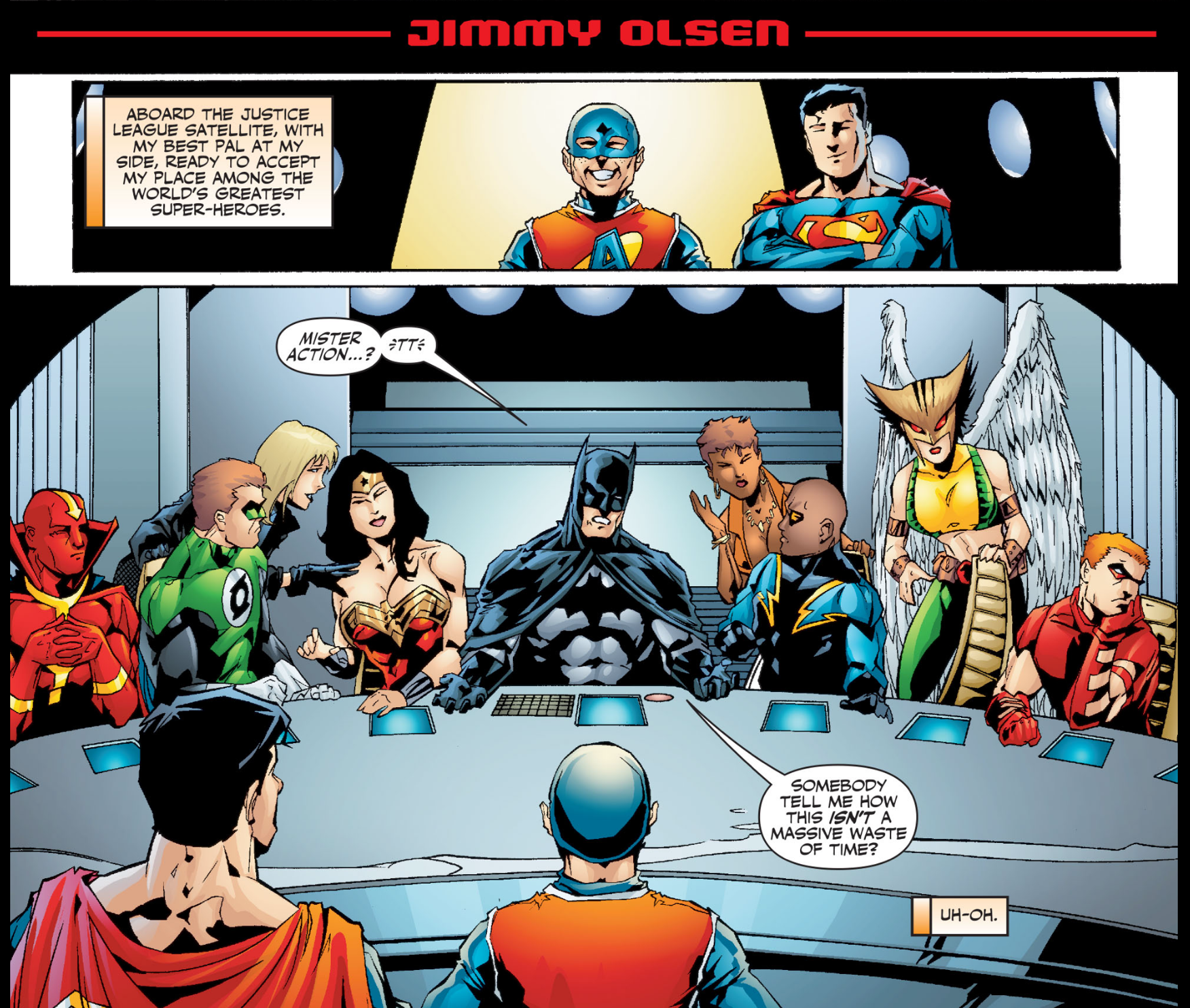
Unfortunately, it turns out that it was only the marketing department that had learned from DC 52. As noted, DC 52 took place during the “missing year” of One Year Later, so it was technically impossible to tie anything from DC 52 into “current” continuity at its publication. Technically, this is not a real problem. DC 52 was the backstory of everybody’s present, and you could deftly have an event that happened “a year ago” tied to a Batman issue that is happening now. It is the whole premise of flashbacks. And DC 52 did dip into that well on occasion. But that is not how comics advertising works. Comics advertising works on big events, and giant billboards and red skies and bubbles that say, “check out Aquaman: Sword of Atlantis #8 for the next thrilling chunk of this story!” DC 52 had none of that overt tie-in nonsense, and the only “current” spin-off DC 52 ever saw was the four issue World War 3 miniseries (something so superfluous, it rarely attaches itself to DC 52 collections). So Countdown was going to correct this problem by directly tying into every significant event in the DC Universe. During the year that Countdown was published, the DC Universe saw Amazons Attack, the Death of the Flash, the Wedding of Green Arrow and Black Canary, the mass kidnapping of every supervillain on the planet, and the fall of Captain Carrot and the Zoo Crew. That is a lot of masters to serve when you are trying to tell your own story…
And, at its core, Countdown’s greatest failure is compromising its own continuity to placate the active DC Universe happening in the background. Countdown did not adhere to DC 52’s strict “real time” philosophy, and it led to some complete insanity across its run. For instance, early in Countdown, Trickster and Pied Piper aid the rest of the Rogues in killing The Flash. They succeed, and, feeling guilty, attend The Flash’s funeral. There, they are both captured for their crimes, and are given shackles that bind the two of them together. They escape, but are now permanently tied together by a device that will shock them and eventually explode if they attempt to separate. And that’s a classic! Two prisoners on the run, and they are literally bound together in their travels! Except… that’s a concept that works for a couple of hours of entertainment. Maybe a few days if you want to get fancy with a cry of O Brother, Where Art Thou or something. Yet Trickster and Pied Piper are somehow on the run for weeks! Maybe 80% of a whole year! And in the comic itself, the way the story (poorly) weaves between characters, it gives the impression that Trickster and Pied Piper leave Flash’s funeral, stop over at Penguin’s for a night, and then are skulking around behind the scenes at Green Lantern and Black Canary’s wedding! Geez, Green Canary, let the coffin at least get in the ground before you’re throwing a party! And the magical shackles later gain a ticking clock of “now detonating in 24 hours”. Holy cow! They better find a solution for this fast! Oooooor the writers could just introduce the idea that Pied Piper can whistle at it, and that does not deactivate or remove the device, but resets the timer, so this whole “ticking clock” thing apparently only ever existed for one “to be continued” page. We had some tension for a glorious three seconds there!

“Can’t stop the countdown, but I sure as hell can slow it down.” That is a microcosm of how Countdown itself is a microcosm of the worst of “shared universe” comics out there. So much of Countdown is given over to holding its breath for the next event, and no one involved is allowed to make an iota of forward momentum for fear of stepping on the toes of another damned event. Jimmy Olsen has superpowers! And he cannot control them, nor does he have any idea where they came from. So we get a few issues of playing around with this concept (Jimmy attempts to be a vigilante, Jimmy attempts to join the Justice League, Jimmy gets punched by Batman)…
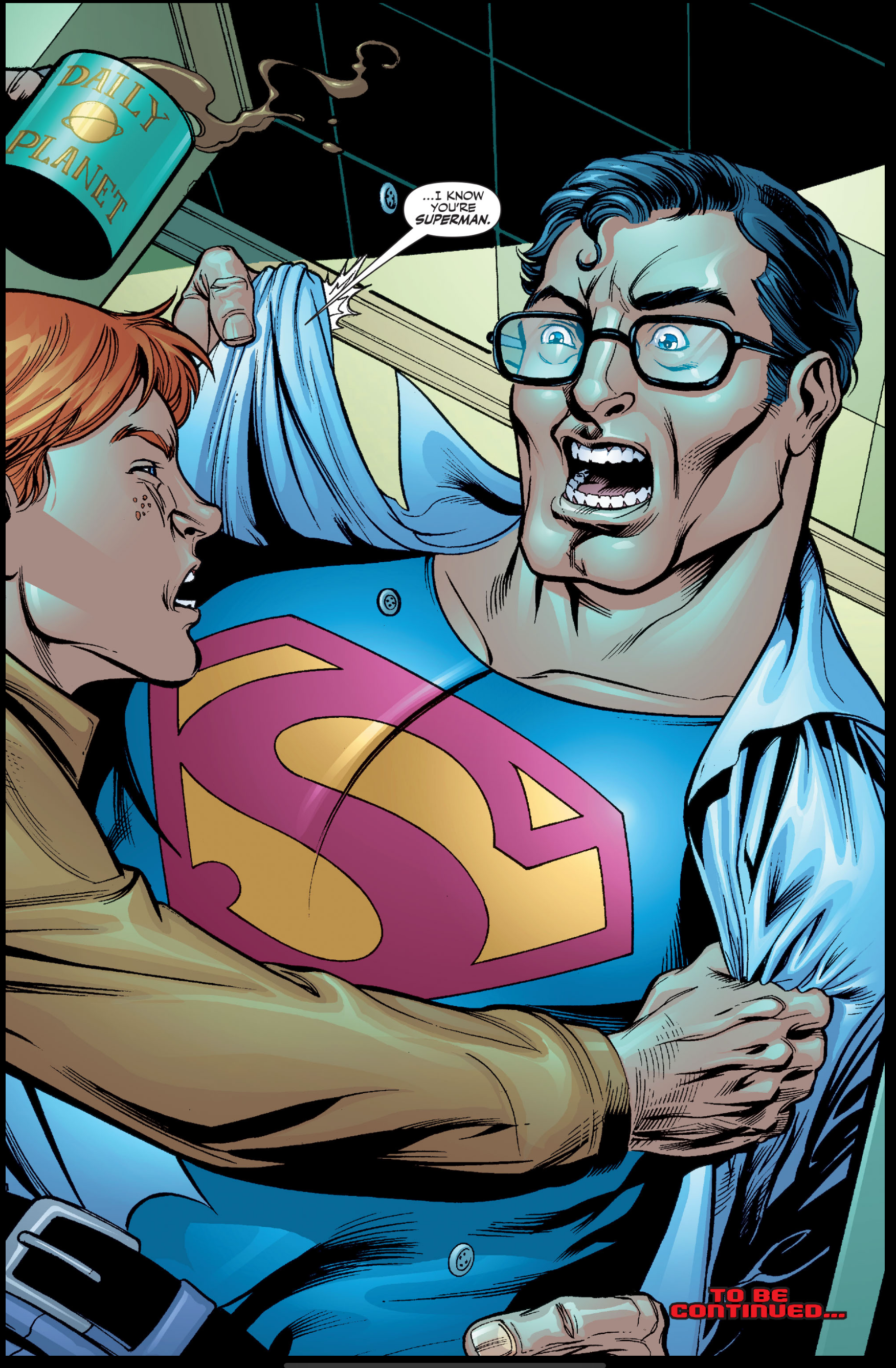
And this should have had an impact on something, but miraculously did not
And then we have months of Jimmy making zero progress as various scientists “test” him with zero success. The solution is exactly what is foreshadowed when this whole story starts: Jimmy Olsen is absorbing powers from dying New Gods. But, since the Death of the New Gods is the event that this whole Countdown is counting down to, Jimmy can only figure out what is going on after a solid 48 issues. And you can only go through about half that many issues with such an obvious answer front and center before you want to strangle your protagonist.
Oh, and speaking of New Gods, Darkseid is the final boss of Countdown. He must be defeated by Superman and Orion, who have barely appeared in this 52-issue series at all, but are Superman and Orion, so of course they are the solution. This is the Level 99 Guest Character doing all the work, except they hang the entire finale on it, and ignore the ostensible protagonists of the previous years’ worth of comics. It is super.
And, Countdown, so help me, you better not be a cunty Darkseid sitting on the couch when I get home.
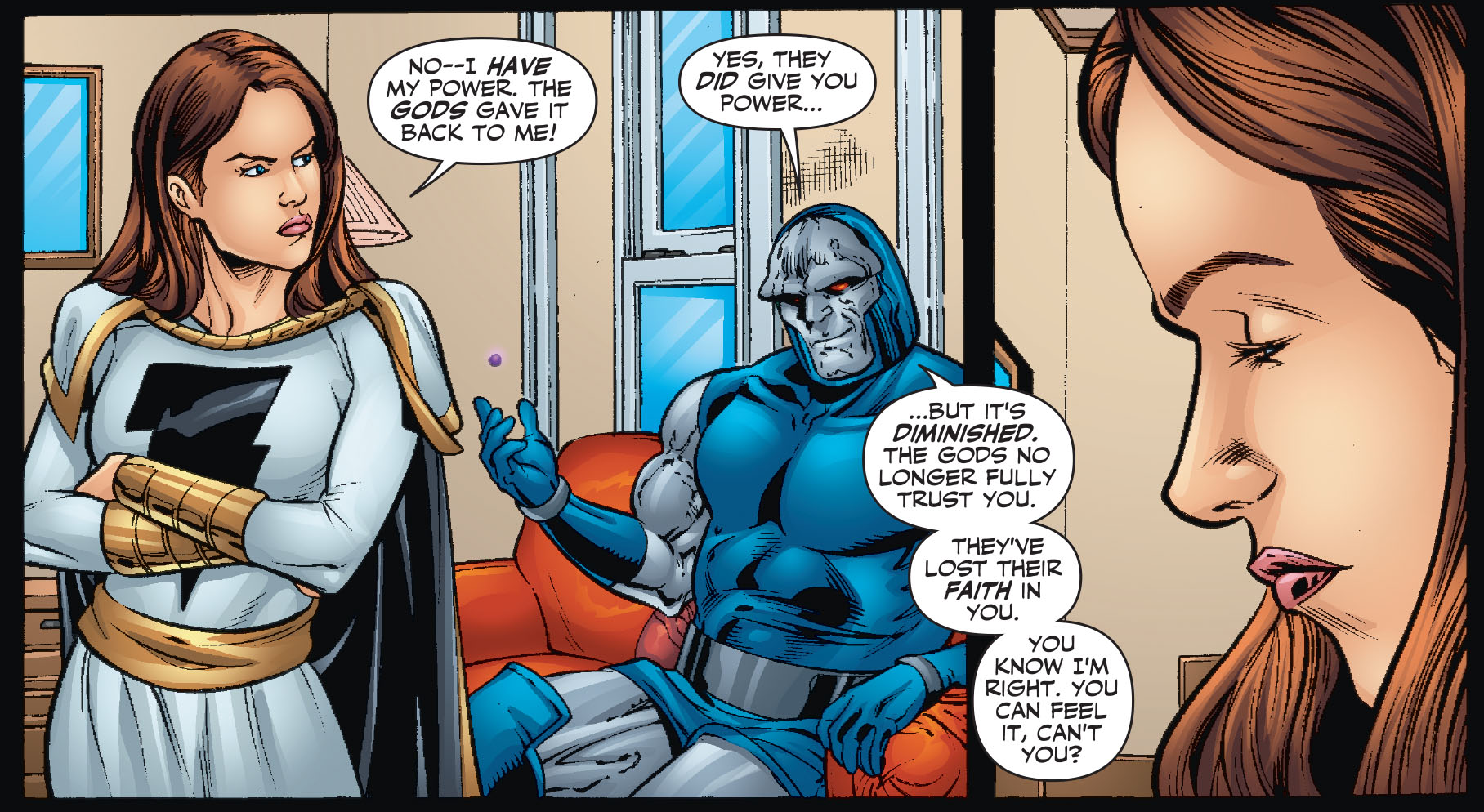
Dammit!
But, despite Darkseid appearing in Countdown from the first issue, there is also a “bigger” conflict going on in Countdown. Like so much in this series, it gets complicated.
From 1986-2006 the DC Universe was solitary. Crisis on Infinite Earths did include infinite Earths, and every single one got ground down to nothing by the Anti-Monitor. In the end, one Earth managed to pull itself back together, and it picked up random protagonists (and cities) from other Earths. Then there were twenty years where DC editorial teased “hypertime” and other concepts that would allow multiverse-based stories to exist. And then we got Infinite Crisis, where the villains were trying to bring back the multiverse, and sorta succeeded. As revealed during the finale of DC 52, Alexander Luthor was able to generate 52 “clone” Earths. All these Earths were the same, but thanks to a vicious misunderstanding of the butterfly effect, an evolved Mr. Mind flapped his wings too hard, and each of the Earths now had alternate histories leading to different Elseworlds. So we have the main DC Universe Earth on Earth-1, and the other 51 Earths can house talking rabbits for all anybody cares. And this was revealed to be the status quo in the absolute last issue of DC 52, so the sequel series would naturally pick up this thread. Thus, Countdown revealed that every new planet has its own attendant, god-like Monitor, and the new Multiverse is in peril! The only solution to this problem is believed to be Ray Palmer, and one Monitor and two or three superheroes from the main universe are going to have to hop worlds to find our hero. Woo! Multiversal Tour!
So we get a few decent issues of Donna Troy, Jason Todd, Kyle Rayner, and Bob the Monitor (I know I’m biased, but good choice of naming there) jumping across The Bleed and exploring the multiverse. Yes, Joker’s Daughter and The Jokester die along the way, but that only impacts, like, one Answer Man.
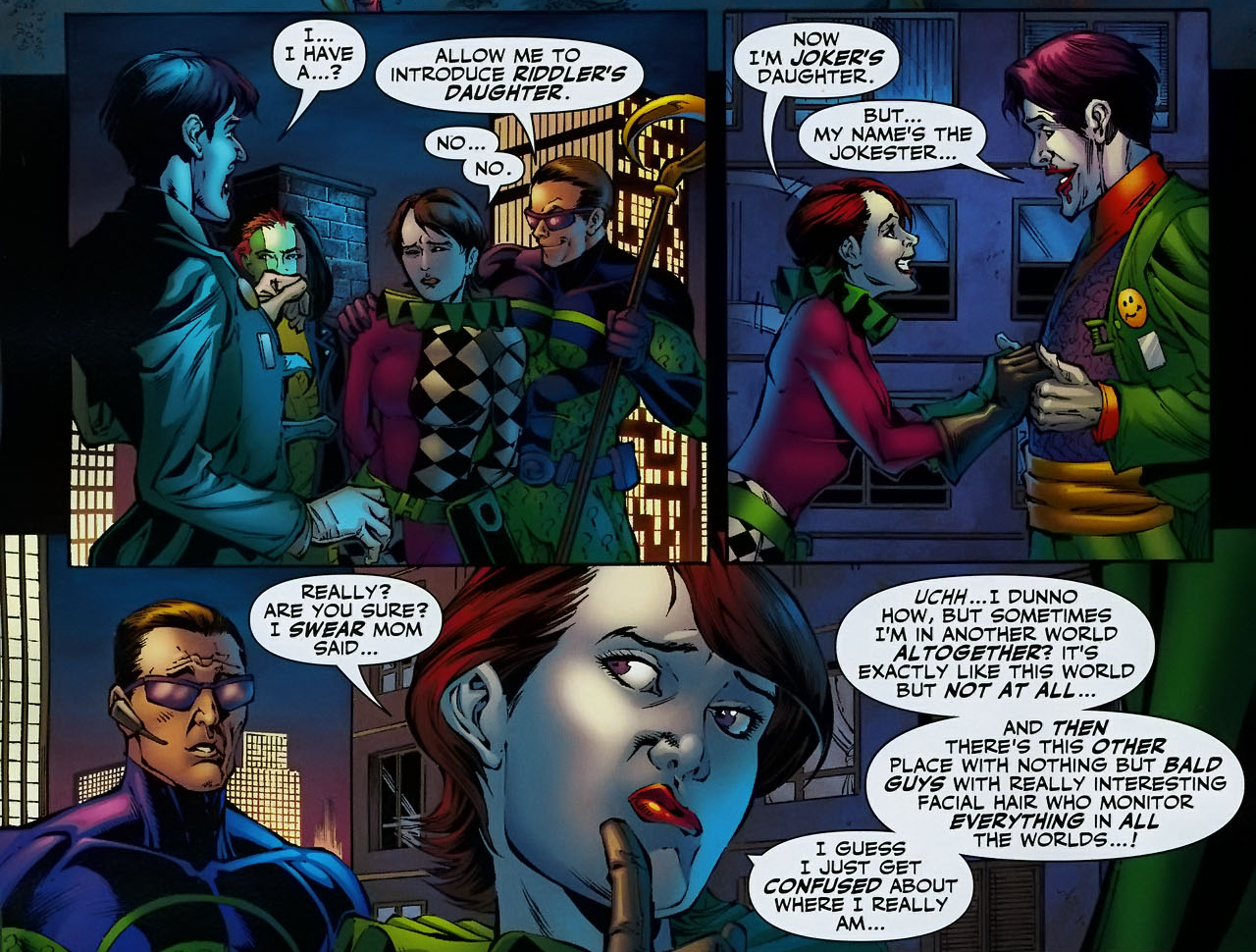
If I had a dime for every time DC Comics wallpapered over continuity errors with “but they were crazy,” I would have at least enough for the subway
Then it is finally revealed that the purpose of this universal tour was all a trick by a different Monitor, Solomon, who apparently has been the good ol’ fashioned villain of the “this was all according to plan” variety in an effort to cause a multiversal war where he absorbs all the powers of all the other Monitors. To this end, Solomonitor has created/recruited The Monarch to play the bad guy to match Team Monitor. This all culminates in a war that destroys one entire version of Earth, vaporizing everything in that universe, save a tiny plant. Then, before Countdown is complete, this planet is rebuilt as an exact duplicate of Earth-1, and then it gets wrecked again, but this time by rats with tiny little baby hands. I am never not amazed by this fact.
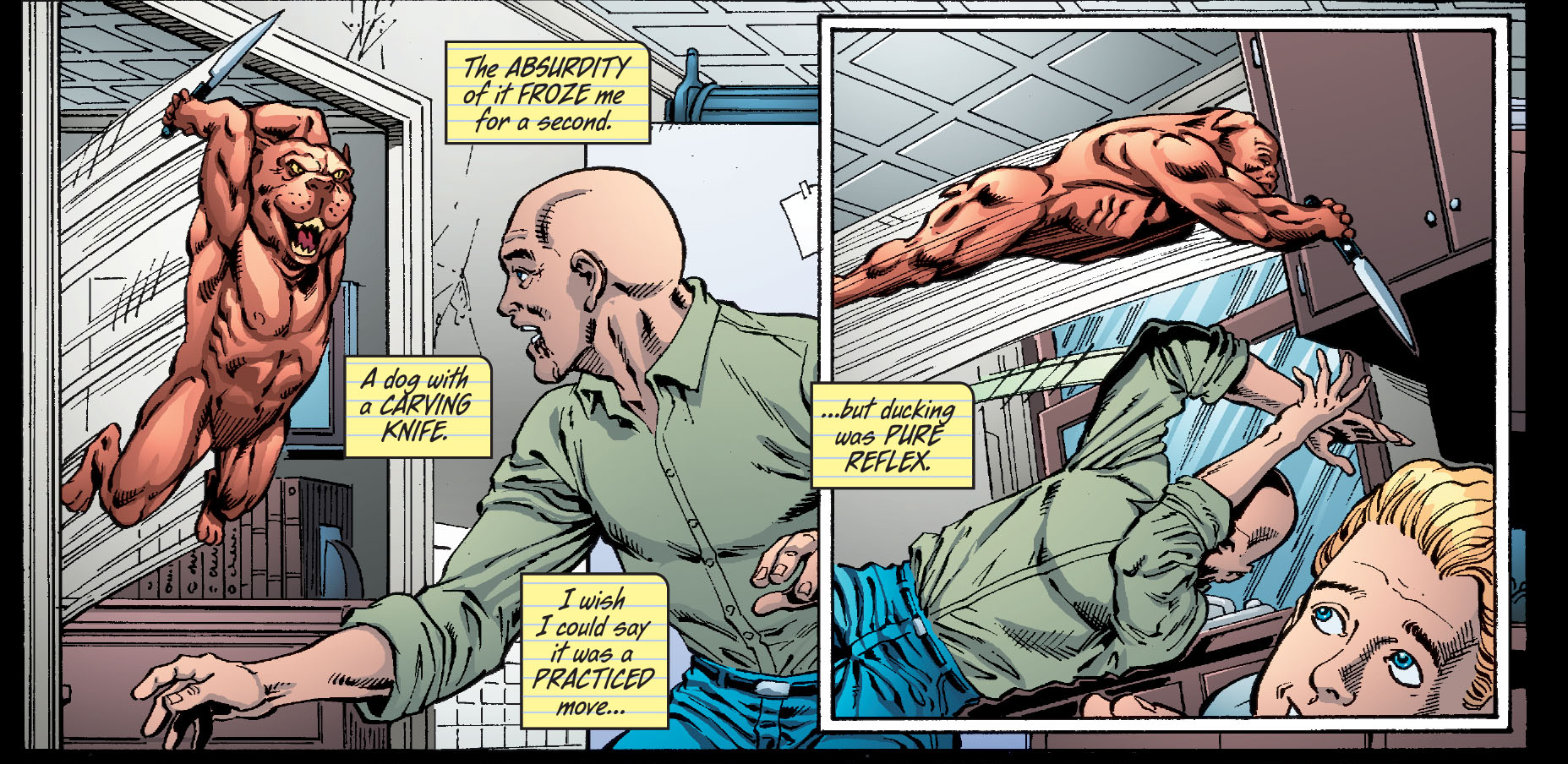
Oh, and this pit bull with a knife. But we are not here to talk about that bad dog, we are here to talk about The Monarch.
(And, in typing that out, God, I want to be talking about the cool Monarch. You know the one.)
DC 52 was a massive hit with practically zero tie-in comics. Countdown was intended to be a massive hit with an equally massive number of tie-in comics. These tie-ins tied-in in the weirdest ways. Countdown to Adventure was a sequel to the DC 52 story of the space adventurers of Animal Man, Starfire, and Adam Strange, but mostly took place on their mundane planets. It had practically nothing to do with Countdown, but it had backup stories about Monarch and Forerunner (even Countdown is not interested in this character for more than ten seconds, so I am going to adopt that philosophy). Countdown to Mystery is another quasi-DC 52 sequel, this time with Kent Nelson learning to live with Ralph Dibny’s old friend, a magic hat. The backup for that one is another direct Countdown tie-in, and features Eclipso, who would menace Mary Marvel for about the middle third of Countdown. Countdown Presents: The Search for Ray Palmer was an expanded look at the world-hopping of the main series, and gave us that world where Batman and Superman are women, and thus curiously 100 times more interesting.
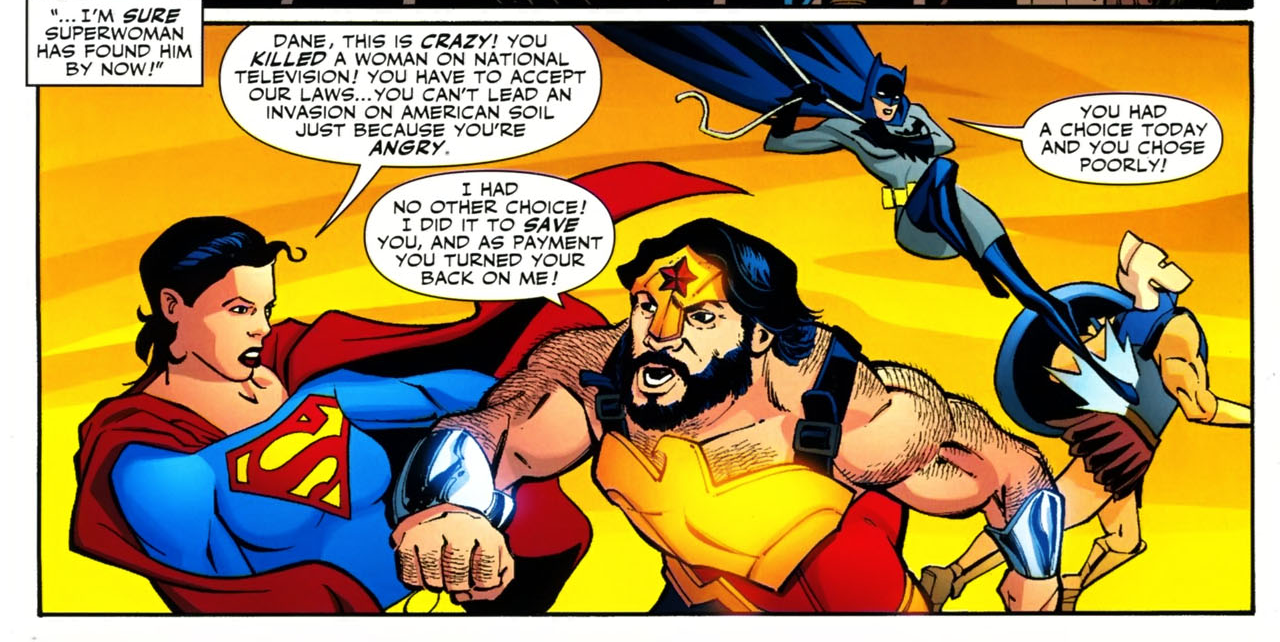
Wonder Man and Hercules should hook up
Countdown Presents: Lord Havok and the Extremists is maybe the most childishly hateful thing I have ever read from one of the big two comics publishers. Basically, Lord Havok and the Extremists are encountered once or twice in Countdown, and this is their backstory. And that backstory? Lord Havok and the Extremists are thinly veiled expys of characters from the Marvel Universe (Lord Havok himself is almost exactly Dr. Doom, and the other Extremists are basically Hulk, Wolverine/Sabretooth, Dormammu, and an unholy amalgamation of Professor X and Magneto), and they live in a faux-Marvel Universe where the Superhero Civil War nonsense went sideways, and “Tin Man” and “Americommando” became President and Vice President of The United States of Angor (this always bothesr me: if it is the United States of Angor, shouldn’t the Captain America expy be “Angorcommando” or similar? I hope someone got fired for that blunder). Anyway, it is a full miniseries that asked the bold question of “what if everyone in the Marvel universe was an asshole?” at time when we had just seen Marvel’s Civil War (2006-2007) and The Ultimates (2002-2008). Nobody needed to ask that question, DC Comics. This would be like Marvel Comics publishing a story where Superman started a zombie plague or something. Bad form.

But the most promising spin-off title was Countdown: Arena. Here’s the setup: halfway through Countdown, everybody forgot this was a story about Darkseid (evil) squaring off with Solomonitor (I guess good?). In the absence of an overt villain, Monarch was tossed in there. Monarch was a villain from a crossover approximately a decade back in DC history. He was a galactic-level threat that was going to be revealed to be Captain Atom, but the readers already guessed it was Captain Atom, so DC revealed he was Hawk (of Hawk and Dove) at the last minute. This time, Monarch’s identity is a secret until it is revealed he is Captain Atom. Presumably this was supposed to be some kind of double feint for anyone that remembered the previous story, but the reveal is about as exciting as the further adventures of Holly Robinson (for more information, don’t bother). But Monarch’s identity is secondary to the fact that he needs to fight the Monitors for nebulous reasons, and he’s going to need an army to pull that off. So Monarch arbitrarily plucks different versions of different superheroes from different universes, and he’s going to take the best versions of each character on a road trip to nuclear Armageddon. Thus, the titular “Arena” refers to the gladiatorial battle between three genetic copies of the same dudes and ladies for multiversal superiority. Woo! Superhero fights!
There is definitely a skeleton of a good idea here. And if you want to see that skeleton actually put some meat on its bones, go ahead and skip ahead to DC’s Convergence, a 2015 crossover where superheroes from different universes/eras fight to mixed results. Or, if you want, you can also read Marvel’s Secret Wars (2015) and Marvel’s Secret Wars (1984). Anywho, Countdown: Arena takes a couple dozen superheroes, and makes ‘em fight for a four-issue (planned) miniseries. While there are a few decent fights in here (Blue Beetle [kinda “our” Jaime] versus Blue Beetle [kinda “our” Ted Kord] versus Blue Beetle [10,000 sentient beetles] is memorable), it is mostly the superheroes of different worlds alternating between crushing despair and attempting to figure out a plan to beat Monarch. So this whole enterprise has the same problem as every piece of Countdown material, and no one can solve anything, as Monarch can only be defeated in the main Countdown series, and all this arguing and planning will literally come to nothing. We could have just had cool fights! The battle between Green Lantern Hal Jordan, Green Lantern Hal Jordan, and Green Lantern Bruce Wayne ending with Hal(s) eating the pavement was tops! Nobody in the audience thought anything would happen with those planning scenes! We knew that from reading Countdown! Why did you waste our precious time!?
But, while the real three-way, three-different Superman fight is more “scripted” for them to team up against Monarch, the Supermen do bicker in each issue wonderfully. On one side, we have a Superman that is “older”, but is seen reporting directly to President Ronny during his introduction. On the other wing, we have Red Son Superman, who is a godless commie, and maybe Golden Age-era Superman smart (thus his ability to make Communism work). And in the third corner of this triangle, we have a character that appears to be closer to a grown-up Kon-El Superboy (but this was the era where DC had to give the estates of Siegel and Shuster one whole sandwich every time someone said “Superboy”, so that naming was forbidden), and has mastered some more cerebral Superman skills. So Superman USA and Superman USSR get along like angry cats, and SuperBuddha “mediates” in a way that pisses both of ‘em off.
And here, ladies and gentlemen, is why I read comics.
DC 52 was amazing. Final Crisis, the event that would eventually cause the floundering Countdown to be renamed Countdown to Final Crisis, was amazing. Countdown was disappointing. Countdown is, at best, middling. It is 52 issues, and I cannot in good conscious advocate anyone waste any portion of their precious time on this Earth to read it. Those 52 issues could have been about anything, but they are about nothing. Doctor 13: Architecture and Morality only got 144 pages and Infectious Lass! You had Karate Kid, Countdown! You could have been amazing!
But here, in a spin-off of a comic that could have been anything, but ultimately proved to be nothing, we have this…
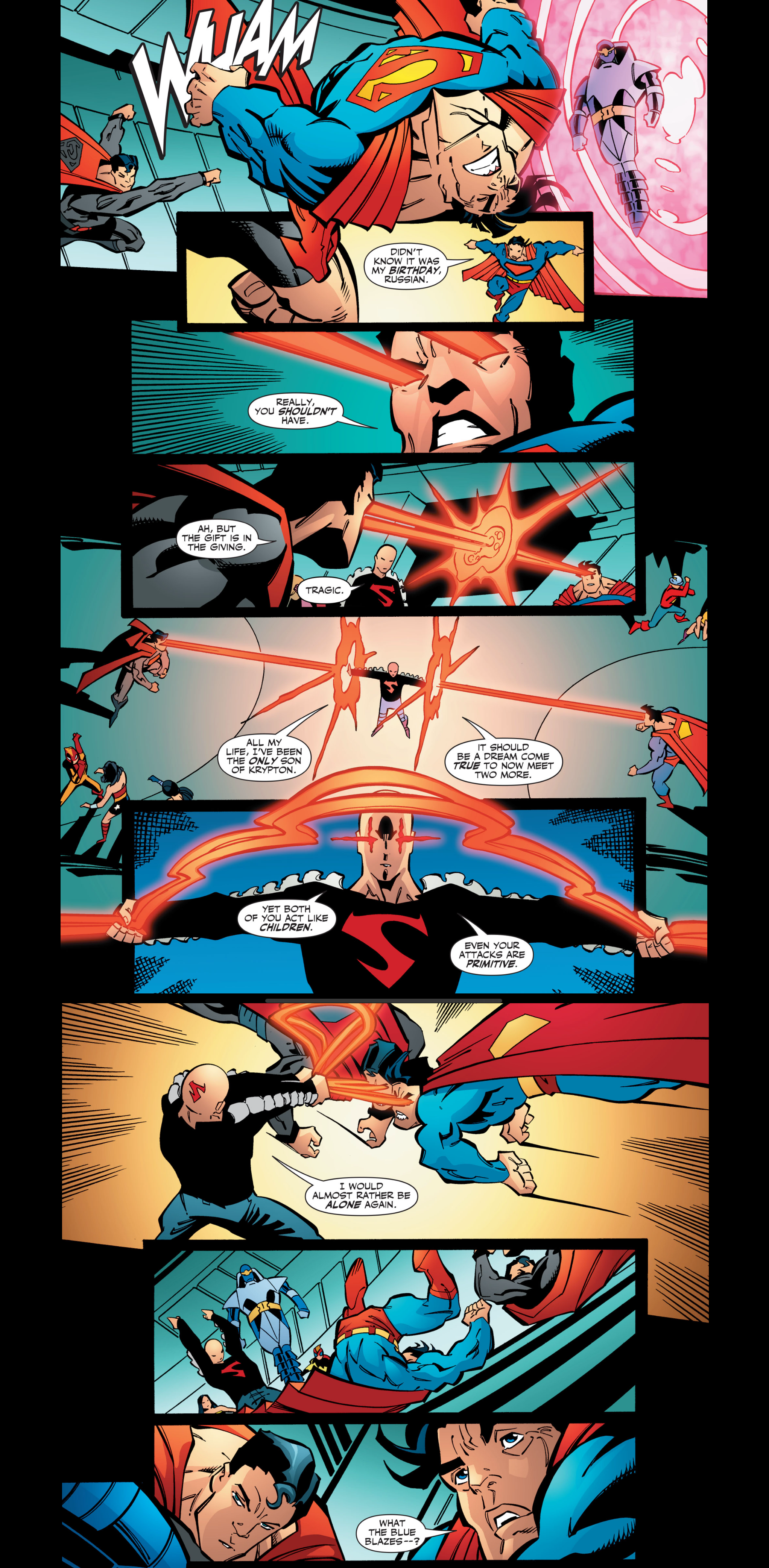
Superman and Superman attempt to heat vision each other, so Superman grabs both heat visions, and swings both Superman and Superman into each other. Bonk. Literally nothing about this makes sense from a perspective of plot, fantasy, or even just physics. It is complete nonsense. I love it.
Comics are awesome.
Next week: Even Worse Streams return with a grab bag of different games. Please look forward to it!

[…] no Breaking Bad.” But since this is a videogame blog and not an all-purpose media site (despite evidence to the contrary), we are going to just hit the bullet points of the Ren & Stimpy phenomenon. To that […]